Nursing Report: Analysis of Patient Problems and Nursing Strategies
VerifiedAdded on 2020/03/28
|8
|1557
|101
Report
AI Summary
This nursing report presents a detailed analysis of three patient problems: laparotomy wound care, imbalanced nutrition due to obesity and a sedentary lifestyle, and insufficient patient education. The report addresses the risk of infection, the need for healthy eating patterns, and the importance of educating the patient and family about the surgical procedure. It includes nursing diagnoses based on NANDA-I, goals for each problem, specific nursing interventions with rationales, and expected outcomes. The interventions cover infection control, dietary planning, and patient and family education on the surgery, potential complications, and self-care strategies. The report references relevant literature to support the nursing interventions and provides a comprehensive plan for patient care.
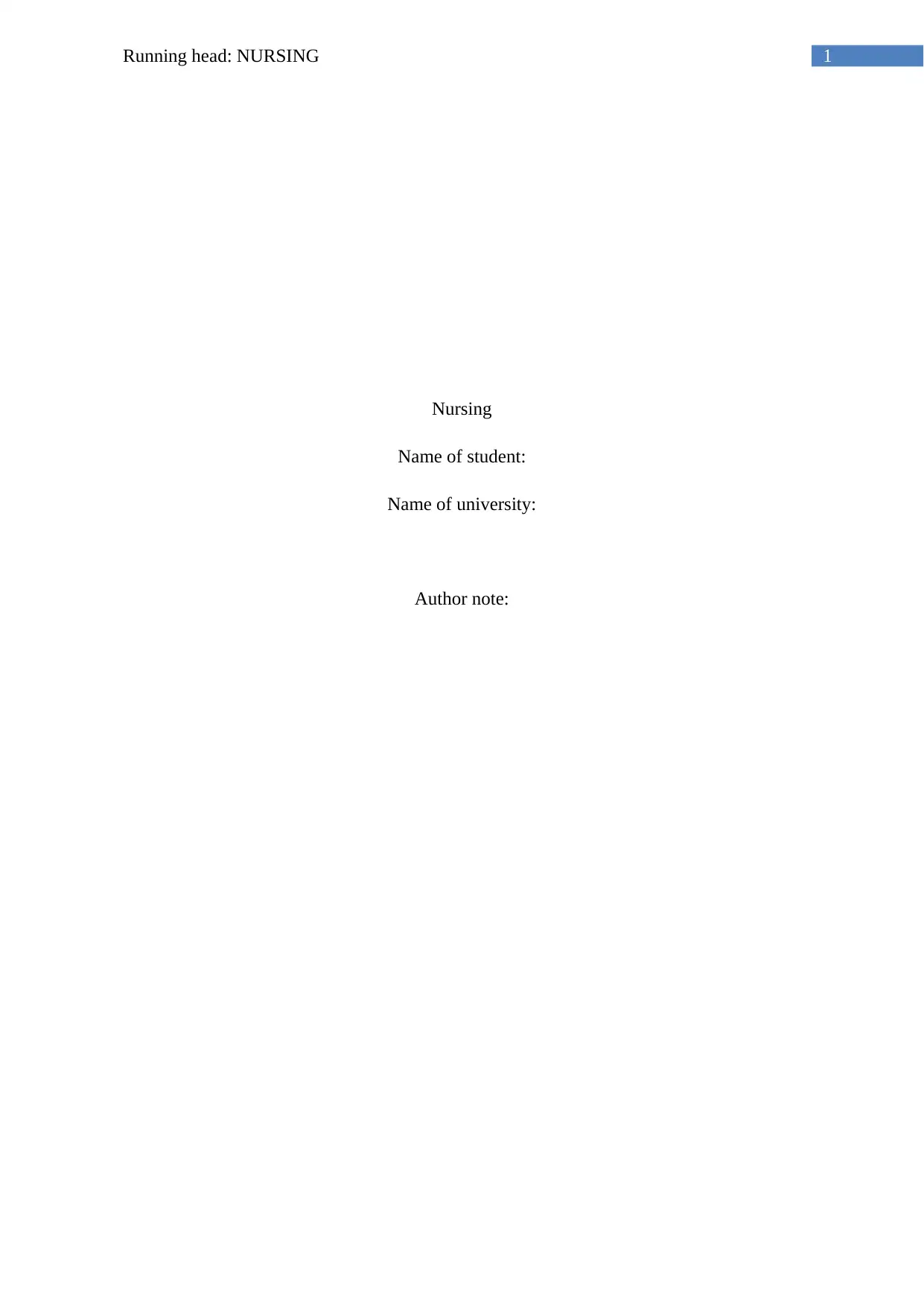
1Running head: NURSING
Nursing
Name of student:
Name of university:
Author note:
Nursing
Name of student:
Name of university:
Author note:
Paraphrase This Document
Need a fresh take? Get an instant paraphrase of this document with our AI Paraphraser
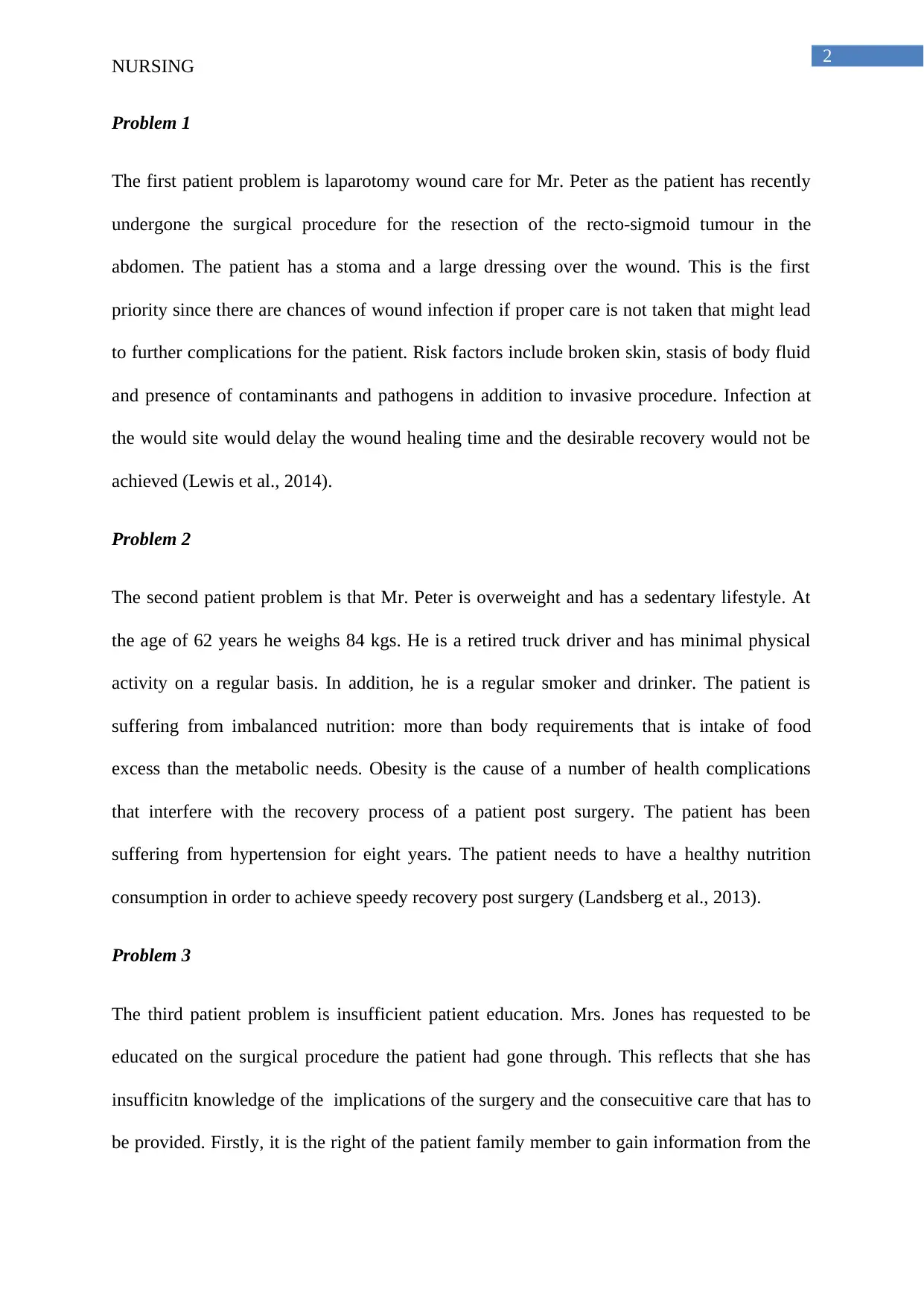
2
NURSING
Problem 1
The first patient problem is laparotomy wound care for Mr. Peter as the patient has recently
undergone the surgical procedure for the resection of the recto-sigmoid tumour in the
abdomen. The patient has a stoma and a large dressing over the wound. This is the first
priority since there are chances of wound infection if proper care is not taken that might lead
to further complications for the patient. Risk factors include broken skin, stasis of body fluid
and presence of contaminants and pathogens in addition to invasive procedure. Infection at
the would site would delay the wound healing time and the desirable recovery would not be
achieved (Lewis et al., 2014).
Problem 2
The second patient problem is that Mr. Peter is overweight and has a sedentary lifestyle. At
the age of 62 years he weighs 84 kgs. He is a retired truck driver and has minimal physical
activity on a regular basis. In addition, he is a regular smoker and drinker. The patient is
suffering from imbalanced nutrition: more than body requirements that is intake of food
excess than the metabolic needs. Obesity is the cause of a number of health complications
that interfere with the recovery process of a patient post surgery. The patient has been
suffering from hypertension for eight years. The patient needs to have a healthy nutrition
consumption in order to achieve speedy recovery post surgery (Landsberg et al., 2013).
Problem 3
The third patient problem is insufficient patient education. Mrs. Jones has requested to be
educated on the surgical procedure the patient had gone through. This reflects that she has
insufficitn knowledge of the implications of the surgery and the consecuitive care that has to
be provided. Firstly, it is the right of the patient family member to gain information from the
NURSING
Problem 1
The first patient problem is laparotomy wound care for Mr. Peter as the patient has recently
undergone the surgical procedure for the resection of the recto-sigmoid tumour in the
abdomen. The patient has a stoma and a large dressing over the wound. This is the first
priority since there are chances of wound infection if proper care is not taken that might lead
to further complications for the patient. Risk factors include broken skin, stasis of body fluid
and presence of contaminants and pathogens in addition to invasive procedure. Infection at
the would site would delay the wound healing time and the desirable recovery would not be
achieved (Lewis et al., 2014).
Problem 2
The second patient problem is that Mr. Peter is overweight and has a sedentary lifestyle. At
the age of 62 years he weighs 84 kgs. He is a retired truck driver and has minimal physical
activity on a regular basis. In addition, he is a regular smoker and drinker. The patient is
suffering from imbalanced nutrition: more than body requirements that is intake of food
excess than the metabolic needs. Obesity is the cause of a number of health complications
that interfere with the recovery process of a patient post surgery. The patient has been
suffering from hypertension for eight years. The patient needs to have a healthy nutrition
consumption in order to achieve speedy recovery post surgery (Landsberg et al., 2013).
Problem 3
The third patient problem is insufficient patient education. Mrs. Jones has requested to be
educated on the surgical procedure the patient had gone through. This reflects that she has
insufficitn knowledge of the implications of the surgery and the consecuitive care that has to
be provided. Firstly, it is the right of the patient family member to gain information from the
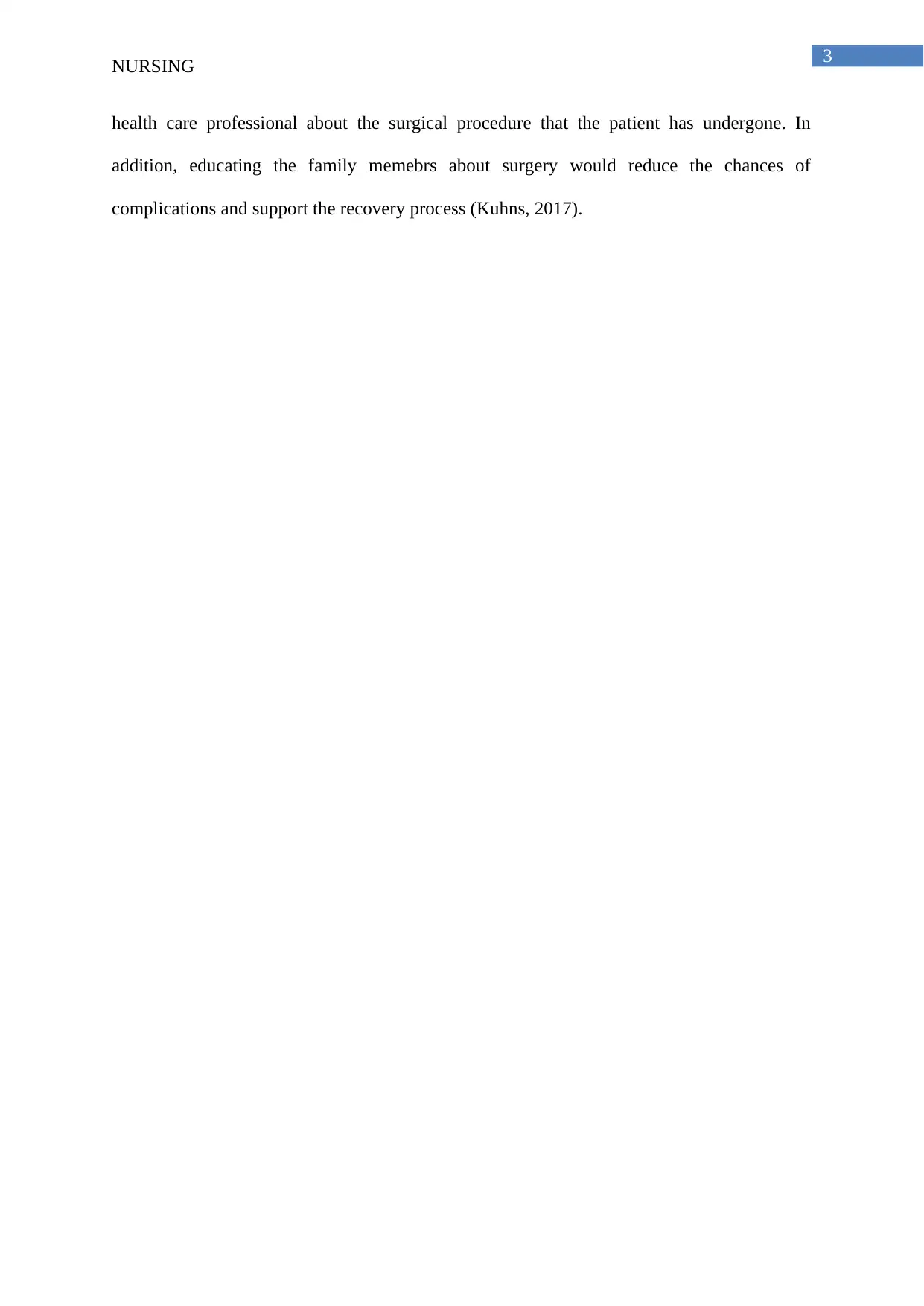
3
NURSING
health care professional about the surgical procedure that the patient has undergone. In
addition, educating the family memebrs about surgery would reduce the chances of
complications and support the recovery process (Kuhns, 2017).
NURSING
health care professional about the surgical procedure that the patient has undergone. In
addition, educating the family memebrs about surgery would reduce the chances of
complications and support the recovery process (Kuhns, 2017).
⊘ This is a preview!⊘
Do you want full access?
Subscribe today to unlock all pages.

Trusted by 1+ million students worldwide
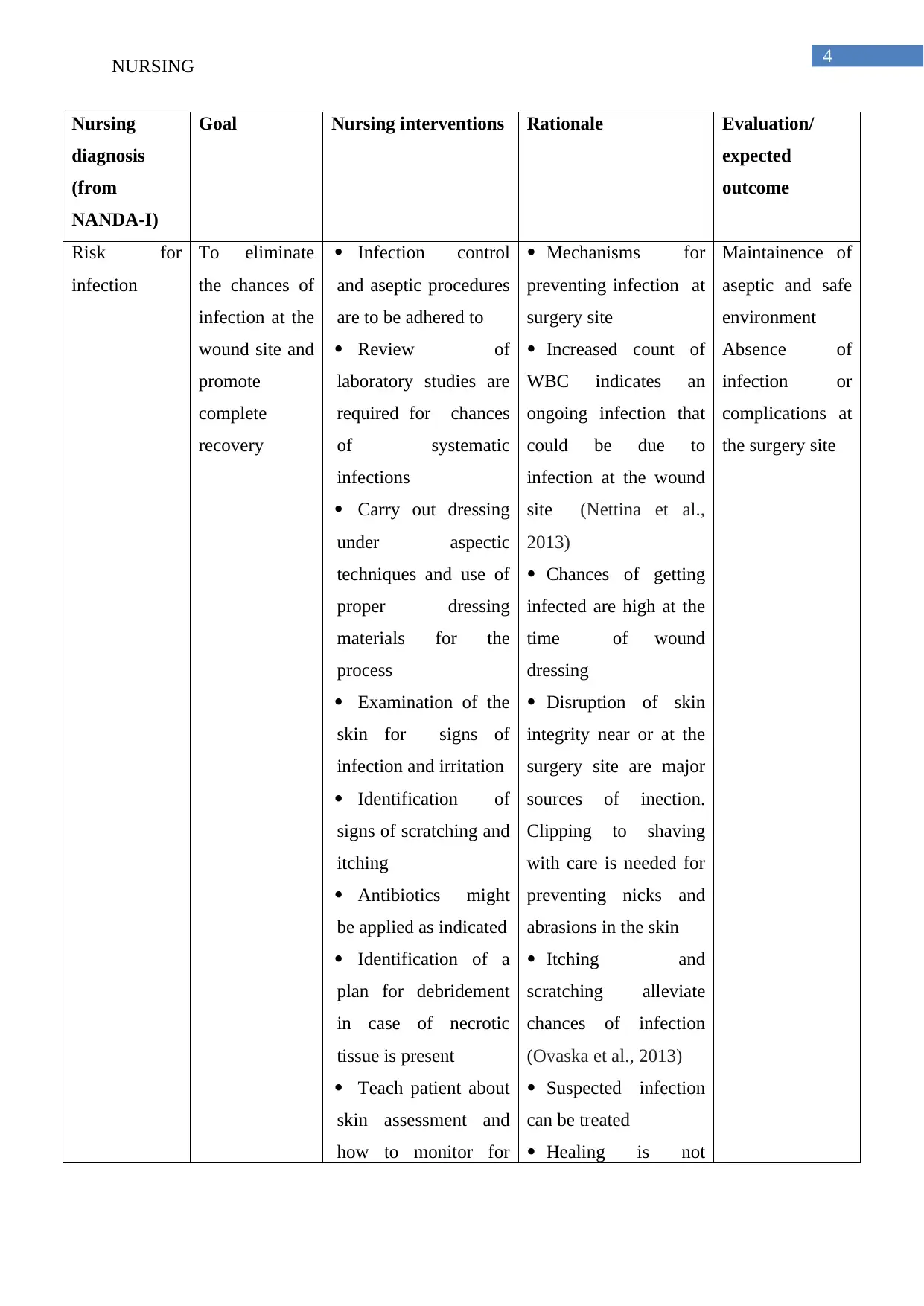
4
NURSING
Nursing
diagnosis
(from
NANDA-I)
Goal Nursing interventions Rationale Evaluation/
expected
outcome
Risk for
infection
To eliminate
the chances of
infection at the
wound site and
promote
complete
recovery
Infection control
and aseptic procedures
are to be adhered to
Review of
laboratory studies are
required for chances
of systematic
infections
Carry out dressing
under aspectic
techniques and use of
proper dressing
materials for the
process
Examination of the
skin for signs of
infection and irritation
Identification of
signs of scratching and
itching
Antibiotics might
be applied as indicated
Identification of a
plan for debridement
in case of necrotic
tissue is present
Teach patient about
skin assessment and
how to monitor for
Mechanisms for
preventing infection at
surgery site
Increased count of
WBC indicates an
ongoing infection that
could be due to
infection at the wound
site (Nettina et al.,
2013)
Chances of getting
infected are high at the
time of wound
dressing
Disruption of skin
integrity near or at the
surgery site are major
sources of inection.
Clipping to shaving
with care is needed for
preventing nicks and
abrasions in the skin
Itching and
scratching alleviate
chances of infection
(Ovaska et al., 2013)
Suspected infection
can be treated
Healing is not
Maintainence of
aseptic and safe
environment
Absence of
infection or
complications at
the surgery site
NURSING
Nursing
diagnosis
(from
NANDA-I)
Goal Nursing interventions Rationale Evaluation/
expected
outcome
Risk for
infection
To eliminate
the chances of
infection at the
wound site and
promote
complete
recovery
Infection control
and aseptic procedures
are to be adhered to
Review of
laboratory studies are
required for chances
of systematic
infections
Carry out dressing
under aspectic
techniques and use of
proper dressing
materials for the
process
Examination of the
skin for signs of
infection and irritation
Identification of
signs of scratching and
itching
Antibiotics might
be applied as indicated
Identification of a
plan for debridement
in case of necrotic
tissue is present
Teach patient about
skin assessment and
how to monitor for
Mechanisms for
preventing infection at
surgery site
Increased count of
WBC indicates an
ongoing infection that
could be due to
infection at the wound
site (Nettina et al.,
2013)
Chances of getting
infected are high at the
time of wound
dressing
Disruption of skin
integrity near or at the
surgery site are major
sources of inection.
Clipping to shaving
with care is needed for
preventing nicks and
abrasions in the skin
Itching and
scratching alleviate
chances of infection
(Ovaska et al., 2013)
Suspected infection
can be treated
Healing is not
Maintainence of
aseptic and safe
environment
Absence of
infection or
complications at
the surgery site
Paraphrase This Document
Need a fresh take? Get an instant paraphrase of this document with our AI Paraphraser
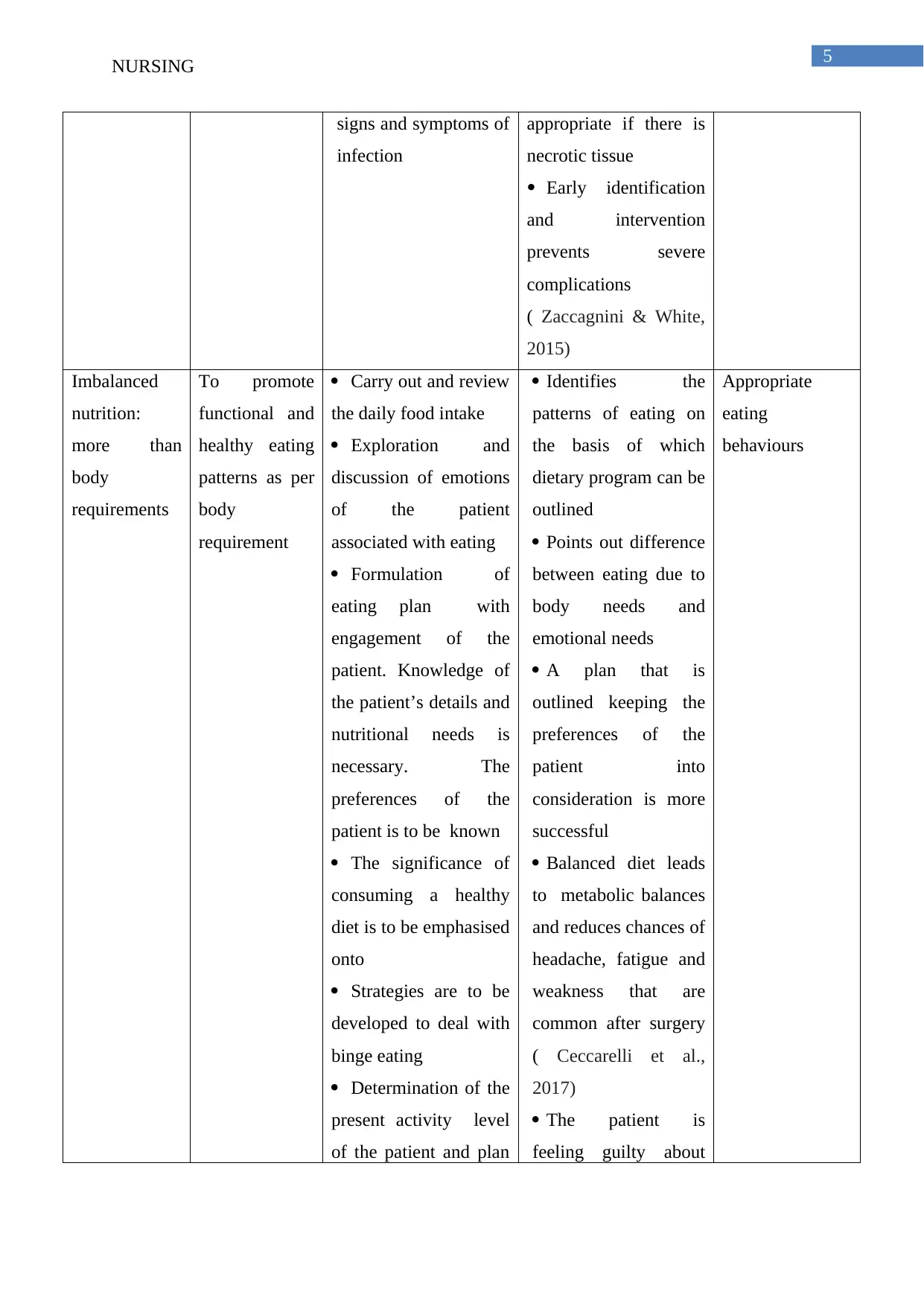
5
NURSING
signs and symptoms of
infection
appropriate if there is
necrotic tissue
Early identification
and intervention
prevents severe
complications
( Zaccagnini & White,
2015)
Imbalanced
nutrition:
more than
body
requirements
To promote
functional and
healthy eating
patterns as per
body
requirement
Carry out and review
the daily food intake
Exploration and
discussion of emotions
of the patient
associated with eating
Formulation of
eating plan with
engagement of the
patient. Knowledge of
the patient’s details and
nutritional needs is
necessary. The
preferences of the
patient is to be known
The significance of
consuming a healthy
diet is to be emphasised
onto
Strategies are to be
developed to deal with
binge eating
Determination of the
present activity level
of the patient and plan
Identifies the
patterns of eating on
the basis of which
dietary program can be
outlined
Points out difference
between eating due to
body needs and
emotional needs
A plan that is
outlined keeping the
preferences of the
patient into
consideration is more
successful
Balanced diet leads
to metabolic balances
and reduces chances of
headache, fatigue and
weakness that are
common after surgery
( Ceccarelli et al.,
2017)
The patient is
feeling guilty about
Appropriate
eating
behaviours
NURSING
signs and symptoms of
infection
appropriate if there is
necrotic tissue
Early identification
and intervention
prevents severe
complications
( Zaccagnini & White,
2015)
Imbalanced
nutrition:
more than
body
requirements
To promote
functional and
healthy eating
patterns as per
body
requirement
Carry out and review
the daily food intake
Exploration and
discussion of emotions
of the patient
associated with eating
Formulation of
eating plan with
engagement of the
patient. Knowledge of
the patient’s details and
nutritional needs is
necessary. The
preferences of the
patient is to be known
The significance of
consuming a healthy
diet is to be emphasised
onto
Strategies are to be
developed to deal with
binge eating
Determination of the
present activity level
of the patient and plan
Identifies the
patterns of eating on
the basis of which
dietary program can be
outlined
Points out difference
between eating due to
body needs and
emotional needs
A plan that is
outlined keeping the
preferences of the
patient into
consideration is more
successful
Balanced diet leads
to metabolic balances
and reduces chances of
headache, fatigue and
weakness that are
common after surgery
( Ceccarelli et al.,
2017)
The patient is
feeling guilty about
Appropriate
eating
behaviours
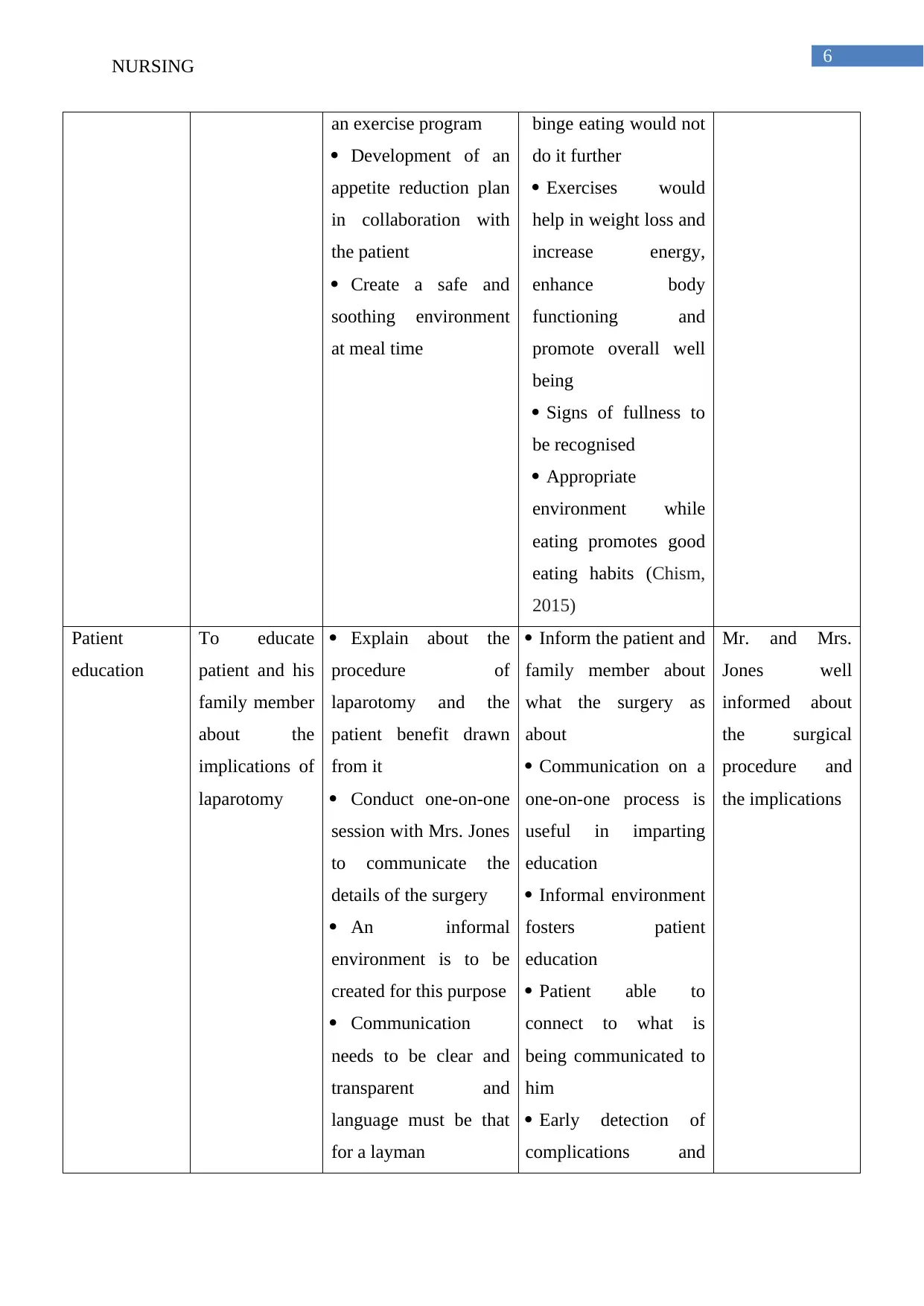
6
NURSING
an exercise program
Development of an
appetite reduction plan
in collaboration with
the patient
Create a safe and
soothing environment
at meal time
binge eating would not
do it further
Exercises would
help in weight loss and
increase energy,
enhance body
functioning and
promote overall well
being
Signs of fullness to
be recognised
Appropriate
environment while
eating promotes good
eating habits (Chism,
2015)
Patient
education
To educate
patient and his
family member
about the
implications of
laparotomy
Explain about the
procedure of
laparotomy and the
patient benefit drawn
from it
Conduct one-on-one
session with Mrs. Jones
to communicate the
details of the surgery
An informal
environment is to be
created for this purpose
Communication
needs to be clear and
transparent and
language must be that
for a layman
Inform the patient and
family member about
what the surgery as
about
Communication on a
one-on-one process is
useful in imparting
education
Informal environment
fosters patient
education
Patient able to
connect to what is
being communicated to
him
Early detection of
complications and
Mr. and Mrs.
Jones well
informed about
the surgical
procedure and
the implications
NURSING
an exercise program
Development of an
appetite reduction plan
in collaboration with
the patient
Create a safe and
soothing environment
at meal time
binge eating would not
do it further
Exercises would
help in weight loss and
increase energy,
enhance body
functioning and
promote overall well
being
Signs of fullness to
be recognised
Appropriate
environment while
eating promotes good
eating habits (Chism,
2015)
Patient
education
To educate
patient and his
family member
about the
implications of
laparotomy
Explain about the
procedure of
laparotomy and the
patient benefit drawn
from it
Conduct one-on-one
session with Mrs. Jones
to communicate the
details of the surgery
An informal
environment is to be
created for this purpose
Communication
needs to be clear and
transparent and
language must be that
for a layman
Inform the patient and
family member about
what the surgery as
about
Communication on a
one-on-one process is
useful in imparting
education
Informal environment
fosters patient
education
Patient able to
connect to what is
being communicated to
him
Early detection of
complications and
Mr. and Mrs.
Jones well
informed about
the surgical
procedure and
the implications
⊘ This is a preview!⊘
Do you want full access?
Subscribe today to unlock all pages.

Trusted by 1+ million students worldwide
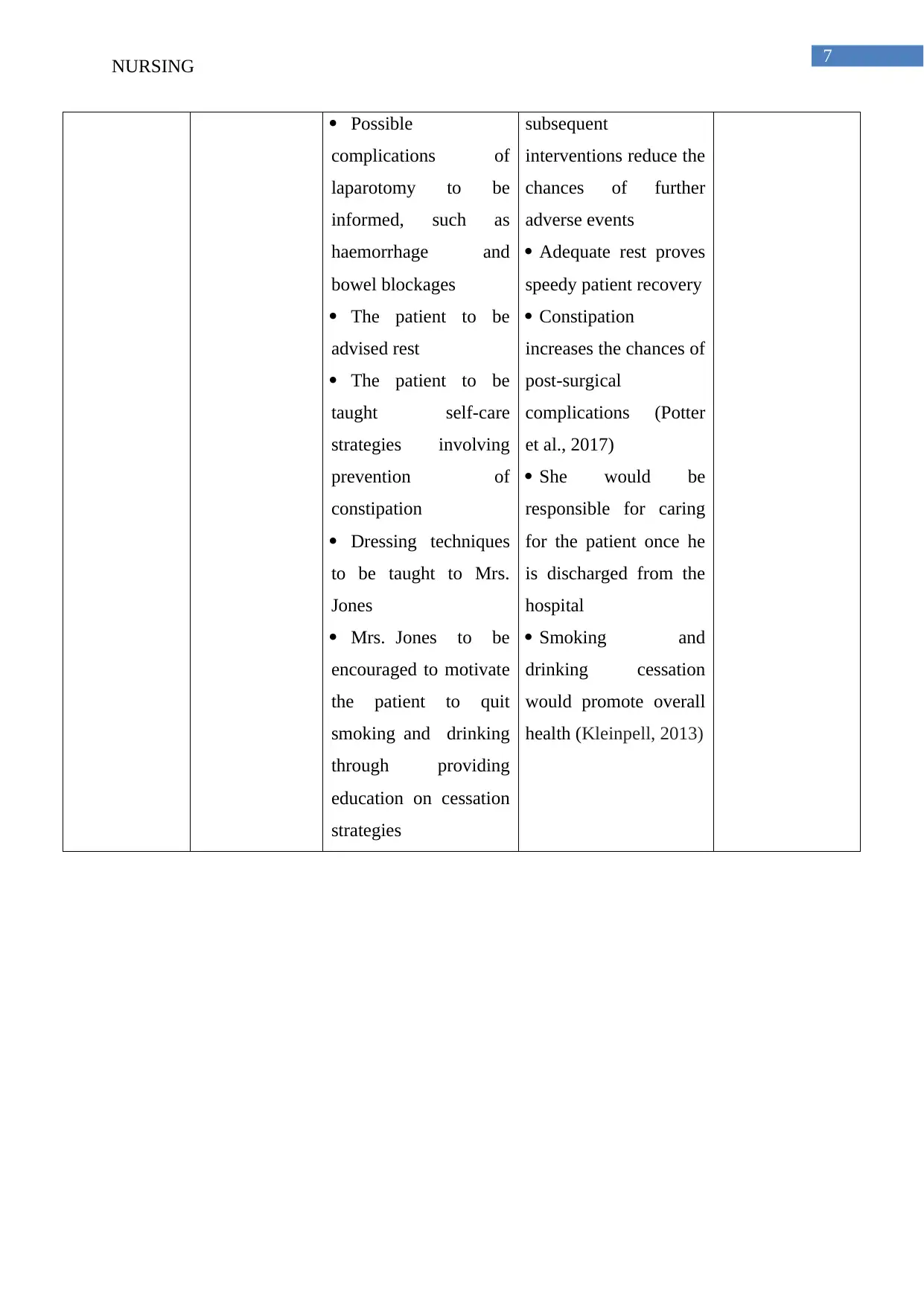
7
NURSING
Possible
complications of
laparotomy to be
informed, such as
haemorrhage and
bowel blockages
The patient to be
advised rest
The patient to be
taught self-care
strategies involving
prevention of
constipation
Dressing techniques
to be taught to Mrs.
Jones
Mrs. Jones to be
encouraged to motivate
the patient to quit
smoking and drinking
through providing
education on cessation
strategies
subsequent
interventions reduce the
chances of further
adverse events
Adequate rest proves
speedy patient recovery
Constipation
increases the chances of
post-surgical
complications (Potter
et al., 2017)
She would be
responsible for caring
for the patient once he
is discharged from the
hospital
Smoking and
drinking cessation
would promote overall
health (Kleinpell, 2013)
NURSING
Possible
complications of
laparotomy to be
informed, such as
haemorrhage and
bowel blockages
The patient to be
advised rest
The patient to be
taught self-care
strategies involving
prevention of
constipation
Dressing techniques
to be taught to Mrs.
Jones
Mrs. Jones to be
encouraged to motivate
the patient to quit
smoking and drinking
through providing
education on cessation
strategies
subsequent
interventions reduce the
chances of further
adverse events
Adequate rest proves
speedy patient recovery
Constipation
increases the chances of
post-surgical
complications (Potter
et al., 2017)
She would be
responsible for caring
for the patient once he
is discharged from the
hospital
Smoking and
drinking cessation
would promote overall
health (Kleinpell, 2013)
Paraphrase This Document
Need a fresh take? Get an instant paraphrase of this document with our AI Paraphraser
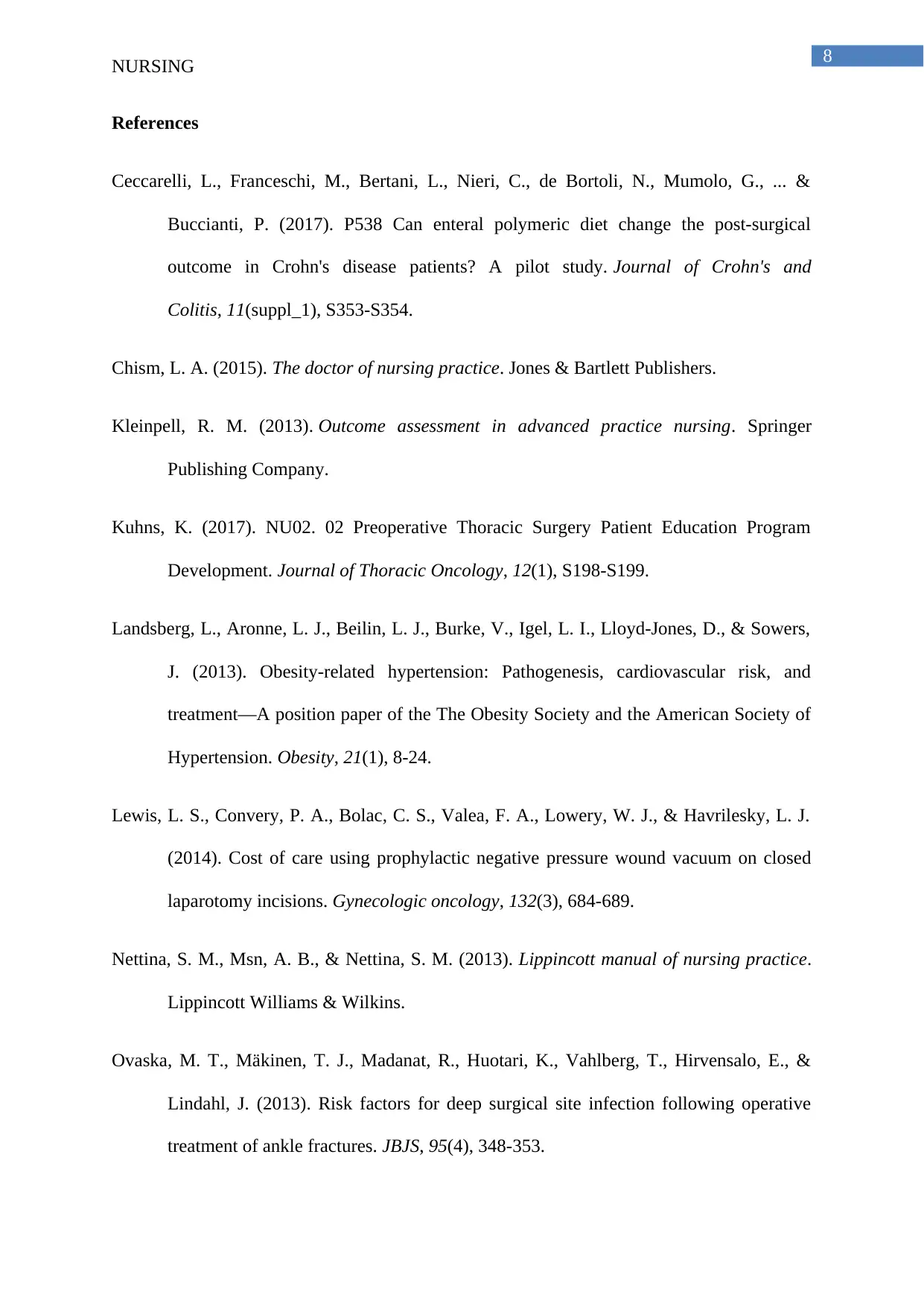
8
NURSING
References
Ceccarelli, L., Franceschi, M., Bertani, L., Nieri, C., de Bortoli, N., Mumolo, G., ... &
Buccianti, P. (2017). P538 Can enteral polymeric diet change the post-surgical
outcome in Crohn's disease patients? A pilot study. Journal of Crohn's and
Colitis, 11(suppl_1), S353-S354.
Chism, L. A. (2015). The doctor of nursing practice. Jones & Bartlett Publishers.
Kleinpell, R. M. (2013). Outcome assessment in advanced practice nursing. Springer
Publishing Company.
Kuhns, K. (2017). NU02. 02 Preoperative Thoracic Surgery Patient Education Program
Development. Journal of Thoracic Oncology, 12(1), S198-S199.
Landsberg, L., Aronne, L. J., Beilin, L. J., Burke, V., Igel, L. I., Lloyd‐Jones, D., & Sowers,
J. (2013). Obesity‐related hypertension: Pathogenesis, cardiovascular risk, and
treatment—A position paper of the The Obesity Society and the American Society of
Hypertension. Obesity, 21(1), 8-24.
Lewis, L. S., Convery, P. A., Bolac, C. S., Valea, F. A., Lowery, W. J., & Havrilesky, L. J.
(2014). Cost of care using prophylactic negative pressure wound vacuum on closed
laparotomy incisions. Gynecologic oncology, 132(3), 684-689.
Nettina, S. M., Msn, A. B., & Nettina, S. M. (2013). Lippincott manual of nursing practice.
Lippincott Williams & Wilkins.
Ovaska, M. T., Mäkinen, T. J., Madanat, R., Huotari, K., Vahlberg, T., Hirvensalo, E., &
Lindahl, J. (2013). Risk factors for deep surgical site infection following operative
treatment of ankle fractures. JBJS, 95(4), 348-353.
NURSING
References
Ceccarelli, L., Franceschi, M., Bertani, L., Nieri, C., de Bortoli, N., Mumolo, G., ... &
Buccianti, P. (2017). P538 Can enteral polymeric diet change the post-surgical
outcome in Crohn's disease patients? A pilot study. Journal of Crohn's and
Colitis, 11(suppl_1), S353-S354.
Chism, L. A. (2015). The doctor of nursing practice. Jones & Bartlett Publishers.
Kleinpell, R. M. (2013). Outcome assessment in advanced practice nursing. Springer
Publishing Company.
Kuhns, K. (2017). NU02. 02 Preoperative Thoracic Surgery Patient Education Program
Development. Journal of Thoracic Oncology, 12(1), S198-S199.
Landsberg, L., Aronne, L. J., Beilin, L. J., Burke, V., Igel, L. I., Lloyd‐Jones, D., & Sowers,
J. (2013). Obesity‐related hypertension: Pathogenesis, cardiovascular risk, and
treatment—A position paper of the The Obesity Society and the American Society of
Hypertension. Obesity, 21(1), 8-24.
Lewis, L. S., Convery, P. A., Bolac, C. S., Valea, F. A., Lowery, W. J., & Havrilesky, L. J.
(2014). Cost of care using prophylactic negative pressure wound vacuum on closed
laparotomy incisions. Gynecologic oncology, 132(3), 684-689.
Nettina, S. M., Msn, A. B., & Nettina, S. M. (2013). Lippincott manual of nursing practice.
Lippincott Williams & Wilkins.
Ovaska, M. T., Mäkinen, T. J., Madanat, R., Huotari, K., Vahlberg, T., Hirvensalo, E., &
Lindahl, J. (2013). Risk factors for deep surgical site infection following operative
treatment of ankle fractures. JBJS, 95(4), 348-353.
1 out of 8
Related Documents
Your All-in-One AI-Powered Toolkit for Academic Success.
+13062052269
info@desklib.com
Available 24*7 on WhatsApp / Email
![[object Object]](/_next/static/media/star-bottom.7253800d.svg)
Unlock your academic potential
Copyright © 2020–2025 A2Z Services. All Rights Reserved. Developed and managed by ZUCOL.





